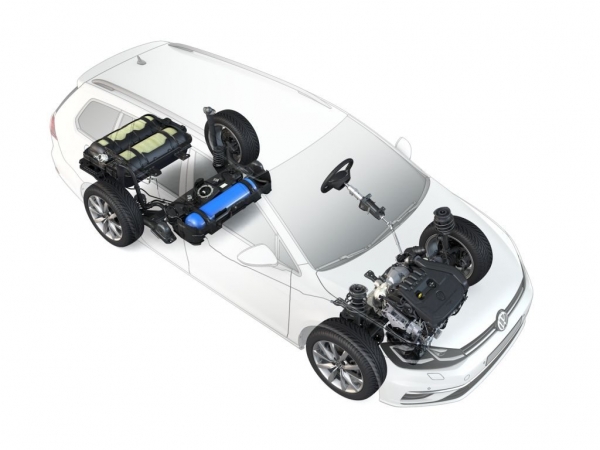15.3.2019. The natural gas-Offensive from Volkswagen continues: Shortly after ordering the start of the Polo TGI and the Golf TGI, there is also the Golf Variant TGI with environmentally friendly natural gas drive.
The new model now has three gas tanks – instead of the previous two. This reinforces once more the long-distance suitability of the CNG engines. And even with three Tanks on Board, you have to make in terms of space, no compromise, because the natural gas storage are integrated as a space-saving Underfloor solution. At the same time, the additional Tank allows for up to 80 kilometres to the increased range in natural gas operation compared to its predecessor.
And to be objective, it is also faster, because under the front hood is a reworked sitting and powerful 1.5-Liter four-cylinder unit with 96 kW (130 HP). Mainly this Motor is operated with CNG (Compressed Natural Gas) the consistent way of reduced gasoline tank fulfils, therefore, more of a reserve function.
The 1.5-litre four-cylinder petrol engine of the Golf Variant TGI is due to the TGI-Miller combustion process and the variable turbine geometry (VTG) of the turbocharger even more efficient and responsive than the previous unit. He makes 96 kW (130 HP) of power and has a torque of 200 Newton meters.
Since the gas tank is what shrunk to nine litres (the equivalent of the Golf Variant TGI a range of about 200 kilometers), and now only as a Reserve is used, one speaks of a quasi-monovalent drive concept. This means: increased range of operation in the pure natural Gas to approximately 80 kilometers. Thus, distances of up to 440 kilometers (WLTP), in the pure natural gas operation is possible.
All three natural gas tanks have a total volume of 115 liters. This corresponds to a total filling of 18.3 kilograms. The Tanks consist of a carbon-fiber-reinforced plastic (CFRP) and metal.
The CO2 emissions of a natural gas vehicle, per se, is significantly lower than that of the comparable conventionally-powered because the combustion of CNG (Compressed Natural Gas), approximately 25 percent less CO2 than the combustion of gasoline fuel. The reason is the low proportion of carbon in natural gas. In addition, natural gas burns so, thanks to the innovative Lambda-Split-process – extremely clean: The exhaust gas contains significantly less carbon monoxide and oxides of nitrogen (NOX) – a minimum proportion of soot or fine dust is the positive result.
Who’s Gas is refueled his vehicle with biomethane or e -, reduces its emissions even further. Because biomethane is obtained from plant residues, e-Gas from excess green electricity (Power-to-Gas). Both are mixed in the fuel or are also available as pure biofuels available.
In addition, the Drive is connected to natural gas in almost all countries, with comparatively low fuel costs. Compared to Diesel, the cost advantage is about 20 percent; for gasoline it is even up to 40 percent. Even though natural gas contains a significantly higher amount of energy. For comparison: One kilogram of CNG corresponds to approximately 1.3 liters of Diesel or 1.5 litres of petrol.
By 2025, the stock of natural gas vehicles in Germany to one Million units. So far, around 100,000 natural gas vehicles registered. In order for this to succeed, on the one hand, expanded the product portfolio and on the other hand, the filling station network to be expanded to 2,000 stations in Europe – so by 2025.
In addition to the eco up! the Polo TGI, Golf TGI and Golf estate TGI, the Volkswagen group currently offers a wide range of 14 CNG vehicles.
Fuel consumption figures:
1. Golf TGI Variant 1,5 TGI fuel consumption natural gas CNG in kg/100 km: urban from 4.7 / extra-urban 3,0 / combined 3,6; CO2 emissions in g/km: 99 energy efficiency class: A+
2. Golf TGI Variant 1,5 TGI fuel consumption natural gas (CNG) in kg/100 km: urban from 4.7 / extra-urban 3,0 / combined 3,6; CO2 emissions in g/km: 99 energy efficiency class: A+
3. Polo TGI fuel consumption natural gas (CNG) in kg/100 km: urban 4,4 – 4,1 / extra-urban 2.9-to 2.7 / combined 3,4-3,2; CO2-Emission in g/km: 93 – 88; efficiency class: A+
4. Golf TGI fuel consumption natural gas (CNG) in kg/100 km: urban 4,7-4,5 / extra-urban 2.9 / combined 3,6-3.5; CO2 emissions in g/km: 98-95; efficiency class: A
5. the eco up! – Fuel consumption-natural gas (CNG) in kg/100 km: urban 3,7-3,6 / extra-urban / 2,6 / combined a 3.0 to 2.9; CO2 emissions combined in g/km: 82-81; efficiency class: A-A+


Golf Variant TGI (photo: Volkswagen AG)